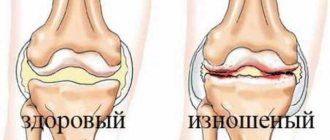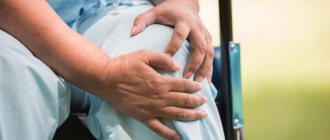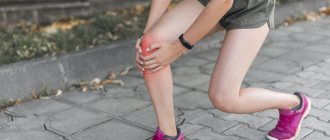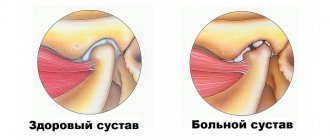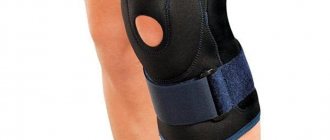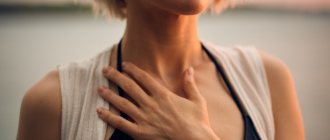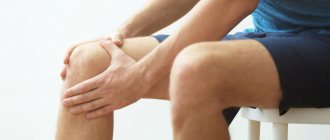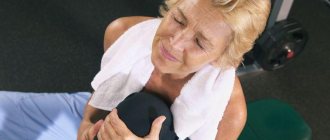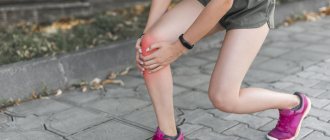Gonarthrosis is not a reason to give up physical activity. Quite the opposite: lack of movement will quickly lead to stagnation in the joint, which means the situation will only worsen. There are simple sets of exercises that are allowed for people undergoing treatment for osteoarthritis. You can start doing them only after taking painkillers. If pain makes itself felt, training should be postponed.
Exercise strengthens the tissue around the knee joint
What should you expect from exercise?
It is a mistake to think that physical therapy for arthrosis of the knee joint can work wonders and completely restore health. If there are irreversible changes in the knees, the problem can be radically solved only with the help of implants. But the operation is not cheap and is not suitable for everyone. Therefore, exercises to develop the knee joint are often the only option to alleviate the condition and improve the patient’s well-being.
With their help you can:
- relieve pain symptoms;
- restore blood circulation in the problem area;
- achieve long-term remission;
- strengthen muscles;
- increase joint mobility;
- improve overall well-being.
You should not expect relief to come after the first session: the results of exercise therapy for knee arthrosis will be noticeable after several weeks of training. However, this is not a reason to relax, because only regular, measured and correct loads can restore the function of the knees. Exercise for arthrosis of the knee joint should become a mandatory daily ritual for those who do not want the disease to worsen.
Clinical diagnosis
To assess the condition of the patient’s body, the doctor prescribes general clinical urine and blood tests. If synovitis occurs in the body in a latent form (as evidenced by the detection of leukocytosis and an increased level of ESR), this indicates the development of inflammation in the joint tissue.
In some cases, serological and biochemical studies may be required. This will help differentiate systemic and infectious diseases. Intra-articular fluid and cartilage tissue can also be collected to carry out a morphological study. This makes it possible to detect degenerative-dystrophic disorders in the articular tissue of the knee.
Principles of exercise therapy for arthrosis
A set of exercises for knee pain is not a panacea, but it still gives good results. But provided that patients strictly follow the specialist’s instructions and adhere to certain principles.
During classes, you should not make sudden movements, even if they are part of a rehabilitation program. An awkward turn or bend can aggravate the situation and cause serious problems with the musculoskeletal system. Although knee extension exercises are a mandatory part of rehabilitation, they should be avoided if pain occurs. If your knee hurts, it means that the physical activity was calculated incorrectly.
Classes should be regular, ideally daily. This is the only way to achieve results and strengthen the muscles of the knee joint. They are what keep the knee in the correct position and ensure its functionality.
Despite the regularity of exercise, physical activity for arthrosis of the knee joint should be small. Therefore, it is very important to alternate exercises with rest, and also to perform the bulk of the exercises for the knee joints in a sitting or lying position. It is important to ensure that the spine remains straight during exercise.
Reasons leading to the development of gonarthrosis
The main cause of the development of the disease is considered to be age-related changes caused by the natural aging of the body, and the disruption of metabolism and blood circulation. Other factors that can provoke the development of the disease include:
- obesity;
- injuries;
- congenital anomalies;
- hereditary tendency to joint diseases;
- rheumatoid arthritis;
- work associated with heavy physical activity.
The risk group includes professional weightlifters.
How the training goes
At the initial stage of exercise therapy, exercises for the knee joint are performed exclusively under the supervision of a specialist. Typically, a workout lasts no more than 60 minutes, of which half the time is spent warming up the muscles. This is very important because the muscles and ligaments must be prepared. For older people, who most often experience arthrosis and, as a rule, cannot boast of muscle elasticity, warm-up can take more than half an hour.
Since when performing exercises for the treatment of arthrosis of the knee joint, the load on problem areas must be dosed, the main part of the training takes place lying down or sitting. Therefore, you should prepare a sports mat in advance. Chairs with hard backs are often used during classes.
As the muscles strengthen, the load on the legs increases. If the patient is in good physical shape, he performs at least 30–50 exercises in one approach, and the number of approaches can reach 3–5 per workout. However, after each approach the body must be given rest. Pauses are usually used to relax muscles and perform breathing exercises.
Proper nutrition for gonarthrosis of the knee joint 2 degrees
If articular pathology is detected, the patient will have to follow some rules regarding his own diet:
- Eat jelly, jelly, jellied fish and other dishes containing gelatin.
- Eliminate regular table salt from your diet. As a replacement, you should use sea or iodized salt when cooking.
- Be sure to diversify your menu with fresh or boiled vegetables, fresh herbs, eggs, legumes, cereals, and bran.
- It is healthy to eat low-fat dairy products, marine fish, boiled beef in small quantities, chicken and rabbit.
- It is recommended to diversify your diet with herbal infusions, still mineral water, green tea, vegetable and fruit juices.
- Refractory fats of animal origin will have to be replaced with vegetable oils.
You will have to give up foods that contribute to the deterioration of the condition of joint tissue and the body as a whole:
- too salty and spicy dishes;
- smoked meats
- sweet sparkling water;
- fatty meat and fish products;
- lard, canned food, semi-finished products;
- buns;
- instant food products;
- mixtures containing preservatives and dyes.
During the day, it is necessary to drink clean water in an amount of about 2 liters, since a lack of fluid can negatively affect the condition of cartilage.
Restoring cartilage tissue requires an integrated approach to treatment. One of the components of therapy is a properly formulated diet. It is also important to reduce weight to a certain level in accordance with the patient’s age and height. Due to excessive stress on the affected joint tissue, healing is slowed down.
What is important to pay attention to
Since training should be daily, classes can be done at home. But only after the basic sets of exercises have been completed under the guidance of a specialist. It is the LKF trainer who must determine the loads and make recommendations for those who want to perform joint exercises for arthrosis of the knee joint at home.
Loads are determined individually, taking into account:
- age;
- general well-being;
- level of physical fitness;
- degree of damage to the knee joint;
- presence of diseases.
Those who train independently still need to periodically attend general training sessions in order to adjust the load and learn new exercises. It is important to remember that the duration of exercise is not determined by health status. There are often cases when refusal of exercise therapy with visible improvement led to exacerbation of arthrosis. That is, you need to be prepared for the fact that physical therapy will now become an integral part of the life of a patient with arthrosis.
What rules to follow
- When performing gymnastics for arthrosis, all movements should be smooth and energetic.
- Before starting training, it is better to consult with a rehabilitation specialist or exercise therapy doctor. Ideally, attend several group classes, and only then move on to home workouts.
- The recommended training schedule is 6-7 times a day for 3-5 minutes.
- The number of repetitions of each exercise is 5 times.
- Never exercise if there is pain. If, after completing the movement, pain makes itself felt even after 15-20 minutes, reduce the number of movements to 5, and then gradually increase to 15, avoiding pain.
Exercises for the knee will only be beneficial if they are not performed through pain.
The most popular exercises for knee arthrosis
Any set of exercises for arthrosis of the knee joint consists of two large groups of exercises. The first are performed in a lying position, the second - while sitting. It is recommended to do the following daily while lying down:
- Bike. The exercise is performed on your back and simulates riding a bicycle. In this case, the legs should be bent at the knees at a right angle.
- Leg bending. You should lie on your back and alternately bend your knees, pulling them as close to your chest as possible.
- Stretching the muscles of the knee joint. You need to lie on your stomach and simultaneously bend your knees, trying to touch your buttocks with your heels.
Such exercises do not require special physical training, but can cause discomfort. Gradually, the knee muscles will strengthen, allowing you to increase the load. The best option is to perform at least 3 approaches in one session, each approach can include repeating the exercise up to 50 times. You should also not ignore the complex designed for sitting exercises. It includes exercises such as:
- Pulling your knees to your chest. You need to sit on a chair with a hard back, lean on it, and then grab one leg at the knee and try to pull it as close to your chest as possible. Then do the same with the other leg, then pull both legs bent at the knees to your chest.
- Pumping muscles. You should place your hands on your knees and lightly press them down, fix them. Then try to tighten your hips as much as possible, making sure to keep your knees still. You need to spend at least 30 seconds in tension, then relax and repeat the exercise again.
- Scissors. This exercise is best performed while sitting on the floor. It is best to fold your arms across your chest: you cannot lean on them. The back should be straight, but without support from the wall or any other vertical object.
You should straighten your spine and try to spread your legs to the sides without touching the floor. The distance to it should be 5–10 cm, then the legs should be brought together. When you can do this exercise quite easily, you should try to cross your legs in the air, imitating scissors.
Many people wonder whether it is possible to squat with arthrosis of the knee joint. There is no consensus on this matter, because any squats put increased stress on the knees and can aggravate the situation. On the other hand, the leg muscles need to be gradually strengthened, and without physical activity this is impossible. Therefore, many experts still recommend performing squats for arthrosis of the knee joint, but in such a way that the center of gravity of the body is shifted. This effect can be achieved if, for example, you hold on to a wall or chair while performing the exercise, which minimizes the load on your knees. But before introducing this seemingly simple exercise into your daily training, you should consult with a physical therapy trainer.
Exercises while sitting on a table
- Sit upright on the table. Clench your palms into fists, lean them on the table, dangle your legs. This relaxation exercise can be done as often as possible.
- In the same position, lift your leg and hold it parallel to the floor for 3 seconds. Make sure your foot is at a 90° angle to your shin. Repeat for the second leg. If you do everything correctly, you will feel tension in the muscles of your lower leg and thigh.
- Stand up and rest your buttocks on the table. Bend your knees slightly and spread them, place your toes to the sides. Without bending your back, bend forward and return to the starting position.
Sitting on a table is a great way to relax the muscles around your knee joints.
Are there any restrictions for playing sports with knee arthrosis?
It would seem that physical therapy should be suitable for everyone who wants to improve their health without resorting to surgery. But exercises to strengthen the knee ligaments are not recommended for everyone. They are not recommended to be performed if you feel unwell and have increased pain in your knees, fever, cold, or high blood pressure. You should not exercise forcefully during exacerbation of any chronic diseases.
Very often, supporters of an active lifestyle try to combine exercise therapy with other sports. Experts recommend paying attention to swimming and cycling at a moderate pace, without serious stress on the knees. But you will have to completely abandon skis and skates. If you have arthrosis of the knees, running is contraindicated, which can be successfully replaced by Nordic walking. You should also not practice strength training with heavy lifting. You will have to give up any types of martial arts, football, hockey, volleyball, where the load on the legs is increased, you need to jump and perform sudden movements. In addition, these sports have a fairly high incidence of injuries, which is unacceptable with knee arthrosis. But yoga, Pilates and stretching with muscle stretching exercises will be very useful.
Methods that complement drug therapy
Physiotherapeutic procedures
Patients are shown mild methods of treatment, such as: laser treatment, magnetic therapy, EHF therapy. These procedures help improve the supply of nutrition to cartilage tissue.
Massage
It is necessary to improve blood circulation (and at the same time the supply of nutrients and oxygen to cartilage cells) and, judging by reviews of the treatment of grade 2 gonarthrosis of the knee joint, helps relieve pain spasms and has a beneficial effect on the general condition of the whole body.
Orthopedic treatment
It is based on wearing special devices that reduce the load on the knee joint. This could include knee pads, wrapping the pathological area with an elastic bandage, or wearing orthopedic shoes and arch supports.
Diet
It involves reducing the consumption of salt, which retains fluid in the body, which contributes to the appearance of edema. For obese patients, a low-calorie diet is required to combat excess weight. This is necessary to reduce stress on the joint.
